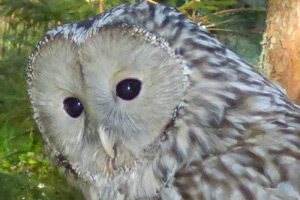Where do they live? Ural owls are inhabitants of large forest masses, giving preference to mixed forests in moist soils. The presence of old and hollow trees in their habitats is important
How do they live? Ural owls are lazy nest builders and always try to use dens prepared by others (for instance, squirrels), nesting places abandoned by other large birds of prey, hollow and semi-hollow trees, fallen trees or large bird boxes.
What do they eat? Ural owls are predators that mainly feed on various small rodents, amphibians (mainly frogs), insects, small and medium birds, as well as other small mammals.
Did you know?
- Ural owls are comparatively aggressive birds - they zealously protect their young. They can even attack people, especially, if the chicks are very young or have just left their nest. During winter, while hunting for mice, Ural owls can dive into a 20-30 cm thick snow cover.
- The mating call of male Ural owls can be heard up to two kilometres and slightly resembles deep and loud barking. The female shouting sounds similar, but in a much more muffled voice.
- How do Ural owls differ from other owls? Ural owls can be differentiated by the comparatively long tail (therefore it is also sometimes called a long-tail owl) and larger body sizes. Ural owls have light grey/brownish plumage with several dark line patterns. Their heads are comparatively small, simple and light, with small black eyes and a yellow beak.

